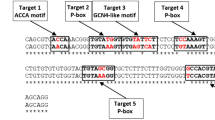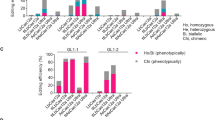Abstract
The 5′ regulatory region of the cbh2 gene of Hypocrea jecorina contains the cbh2 activating element (CAE) which is essential for induction of cbh2 gene expression by sophorose and cellulose. The CAE consists of two motifs, a CCAAT box on the template strand and a GTAATA box on the coding strand, which cooperate during induction. Northern analyses of cbh2 gene expression has revealed an absolute dependence on induction, but no direct effect of Cre1-mediated carbon catabolite repression. Investigation of the chromatin structure in the wild-type strain showed that, under repressing conditions, there is a nucleosome free region (nfr) around the CAE, which is flanked by strictly positioned nucleosomes. Induction results in a loss of positioning of nucleosomes −1 and −2 downstream of the CAE, thus making the TATA box accessible. Simultaneous mutation of both motifs of the CAE, or of the CCAAT-box alone, also leads to shifting of nucleosome −1, which normally covers the TATA-box under repressing conditions, whereas mutation of the GTAATA element results in a narrowing of the nfr, indicating that the proteins that bind to both motifs in the CAE interact with chromatin, although in different ways. A cellulase-negative mutant strain, which has previously been shown to be altered in protein binding to the CAE, still displayed the induction-specific changes in nucleosome structure, indicating that none of the proteins that directly interact with CAE are affected, and that nucleosome rearrangement and induction of cbh2 expression are uncoupled. Interestingly, the carbon catabolite repressor Cre1 is essential for strict nucleosome positioning in the 5′ regulatory sequences of cbh2 under all of the conditions tested, and induction can occur in a promoter that lacks positioned nucleosomes. These data suggest that Cre1, the Hap2/3/5 complex and the GTAATA-binding protein are all involved in nucleosome assembly on the cbh2 promoter, and that the latter two respond to inducing conditions by repositioning nucleosome −1.






Similar content being viewed by others
References
Agalioti T, Lomvardas S, Parekh BS, Maniatis T, Thanos D (2000) Ordered recruitment of chromatin modifying and general transcription factors to the IFN-β promoter. Cell 103:667–678
Aro N, Saloheimo A, Ilmen M, Penttilä M (2001) ACEII, a novel transcriptional activator involved in regulation of cellulase and xylanase genes of Trichoderma reesei. J Biol Chem 276:24309–24314
Beato M, Eisfeld K (1997) Transcription factor access to chromatin. Nucleic Acids Res 25:3559–3563
Chomczynski P, Sacchi N (1987) Single step method for RNA isolation by acidic guanidinium thiocyanate-phenol-chlorophorm extraction. Anal Biochem 162:156–159
Cziferszky A, Mach RL, Kubicek CP (2002) Phosphorylation positively regulates DNA-binding of the carbon catabolite repressor Cre1 of Hypocrea jecorina ( Trichoderma reesei). J Biol Chem 277:14688–14694
Deckert J, Struhl K (2001) Histone acetylation at promoters is differentially affected by specific activators and repressors. Mol Cell Biol 21:2726–2735
Di Mauro E, Kendrew SG, Caserta M (2000) Two distinct nucleosome alterations characterize chromatin remodeling at the Saccharomyces cerevisiae ADH2 promoter. J Biol Chem 275:7612–7618
Dowzer CE, Kelly JM (1991) Analysis of the creA gene, a regulator of carbon catabolite repression in Aspergillus nidulans. Mol Cell Biol 11: 5701–5709
Gonzalez R, Scazzocchio C (1997) A rapid method for chromatin structure analysis in the filamentous fungus Aspergillus nidulans. Nucleic Acids Res 25:3955–3956
Gregory PD (2001) Transcription and chromatin converge: lessons from yeast genetics. Curr Opin Genet Dev 11:142–147
Gregory PD, Schmid A, Zavari M, Münsterkötter M, Hörz W (1999) Chromatin remodelling at the PHO8 promoter requires SWI-SNF and SAGA at a step subsequent to activator binding. EMBO J 18:6407–6414
Hynes MJ, Davis MA (1996) Regulation of acetamide catabolism. In: Brambl R, Marzluf G (eds) The Mycota III: biochemistry and molecular biology. Springer, New York, pp 381–393
Ilmen M, Thrane C, Penttilä M (1996a) The glucose repressor gene cre1 of Trichoderma: isolation and expression of a full-length and a truncated mutant form. Mol Gen Genet 251:451–460
Ilmen M, Onnela ML, Klemsdal S, Keränen S, Penttilä M (1996b) Functional analysis of the cellobiohydrolase I promoter of the filamentous fungus Trichoderma reesei. Mol Gen Genet 253:303–314
Ilmen M, Saloheimo A, Onnela ML, Penttilä M (1997) Regulation of cellulase gene expression in the filamentous fungus Trichoderma reesei. Appl Environ Microbiol 63:1298–1306
Krebs JE, Fry CJ, Samuels ML, Peterson CL (2000) Global role for chromatin remodeling enzymes in mitotic gene expression. Cell 102:587–598
Kubicek CP, Penttilä M (1998) Regulation of production of plant polysaccharide degrading enzymes by Trichoderma reesei. In: Harman GE, Kubicek CP (eds) Trichoderma and Gliocladium, vol 2. Taylor and Francis, London, pp 49–72
Kubicek CP, Messner R, Gruber F, Mandels M, Kubicek-Pranz EM (1993) Triggering of cellulase biosynthesis by cellulose in Trichoderma reesei. Involvement of a constitutive, sophorose-inducible, glucose-inhibited beta-diglucoside permease. J Biol Chem 268:19364–19368
Mach RL, Schindler M, Kubicek CP (1994) Transformation of Trichoderma reesei based on hygromycinB resistance using homologous expression signals. Curr Genet 25:567–570
Mach RL, Strauss J, Zeilinger S, Schindler M, Kubicek CP (1996) Carbon catabolite repression of xylanase I ( xyn1) gene expression in Trichoderma reesei. Mol Microbiol 21:1273–1281
McPherson CE, Shim EY, Friedman DS, Zaret KS (1993) An active tissue-specific enhancer and bound transcription factors existing in a precisely positioned nucleosomal array. Cell 75:387–398
Merika M, Thanos D (2001) Enhanceosomes. Curr Opin Biochem Mol Biophys 11:205–208
Montenecourt BS, Eveleigh DE (1979) Selective screening methods for the isolation of high yielding cellulase mutants of Trichoderma reesei. Adv Chem 181: 289–301
Muro-Pastor M, Gonzalez R, Strauss J, Narendja F, Scazzocchio C (1999) The GATA factor AreA is essential for chromatin remodelling in a eukaryotic bidirectional promoter. EMBO J 18:1584–1597
Narendja F, Davis MA, Hynes MJ (1999) AnCF, the CCAAT binding complex of Aspergillus nidulans, is essential for the formation of a DNaseI-hypersensitive site in the 5′ region of the amdS gene. Mol Cell Biol 19:6523–6531
Sambrook J, Fritsch EF, Maniatis T (1989) Molecular cloning: a laboratory manual (2nd edn). Cold Spring Harbor Laboratory Press, Cold Spring Harbor, N.Y.
Seiboth B, Messner R, Gruber F, Kubicek CP (1992) Disruption of the Trichoderma reesei cbh2 gene coding for cellobiohydrolase II leads to a delay in the triggering of cellulase formation by cellulose. J Gen Microbiol 138:1259–1264
Shen CH, Leblanc BP, Alfieri JA, Clark DJ (2001) Remodeling of yeast CUP1 chromatin involves activator-dependent repositioning of nucleosomes over the entire gene and flanking sequences. Mol Cell Biol 21:534–547
Stangl H, Gruber F, Kubicek CP (1993) Characterization of the Trichoderma reesei cbh2 promoter. Curr Genet 23:115–122
Steidl S, Papagiannopoulos P, Litzka O, Afrianopoulos A, Davis MA, Brakhage A, Hynes MJ (1999) AnCF, the CCAAT binding complex of Aspergillus nidulans, contains products of the hapB, hapC and hapE genes and is required for activation by the pathway-specific regulatory gene amdR. Mol Cell Biol 19:99–106
Strauss J, Mach RL, Zeilinger S, Hartler G, Stöffler G, Wolschek M, Kubicek CP (1995) Cre1, the carbon catabolite repressor protein from Trichoderma reesei. FEBS Lett 376:103–107
Svaren J, Hörz W (1997) Transcription factors vs. nucleosomes: regulation of the PHO5 promoter in yeast. Trends Biochem Sci 22:93–97
Tanaka A, Kamei K, Tanoue S, Papagiannopoulos P, Steidl S, Brakhage AA, Davis MA, Hynes MJ, Kato M, Kobayashi T, Tsukagoshi N (2001) AoHapB, AoHapC and AoHapE, subunits of the Aspergillus oryzae CCAAT-binding complex, are functionally interchangable with the corresponding subunits in Aspergillus nidulans. Curr Genet 39:175–182
Wolschek MF, Narendja F, Karlseder J, Kubicek CP, Scazzocchio C, Strauss J (1998) In situ detection of protein-DNA interactions in filamentous fungi by in vivo footprinting. Nucleic Acids Res 26:3862–3864
Workman JL, Kingston RE (1998) Alteration of nucleosome structure as a mechanism of transcriptional regulation. Annu Rev Biochem 67:545–579
Wu C (1980) The 5′ ends of Drosophila heat shock genes in chromatin are hypersensitive to DNase I. Nature 286:854–860
Yu Y, Eriksson P, Stillman DJ (2000) Architectural transcription factors and the SAGA complex function in parallel pathways to activate transcription. Mol Cell Biol 20:2350–2357
Zeilinger S, Mach RL, Kubicek CP (1998) Two adjacent protein binding motifs in the cbh2 (cellobiohydrolase II-encoding) promoter of the fungus Hypocrea jecorina ( Trichoderma reesei) cooperate in the induction by cellulose. J Biol Chem 273:34463–34471
Zeilinger S, Haller M, Mach RL, Kubicek CP (2000) Molecular characterization of a cellulase-negative mutant of Hypocrea jecorina. Biochem Biophys Res Comm 277:581–588
Zeilinger S, Ebner A, Marosits T, Mach RL, Kubicek CP (2001) The Hypocrea jecorina Hap 2/3/5 protein complex binds to the inverted CCAAT-box (ATTGG) within the cbh2 (cellobiohydrolase II-gene) activating element. Mol Genet Genomics 266:56–63
Acknowledgements
This work was supported by a grant from the Fonds zur Förderung Wissenschaftlicher Forschung (P13672) to CPK. We thank A. Czsifersky for providing strain CK11
Author information
Authors and Affiliations
Corresponding author
Additional information
Communicated by C. A. M. J. J. van den Hondel
Rights and permissions
About this article
Cite this article
Zeilinger, S., Schmoll, M., Pail, M. et al. Nucleosome transactions on the Hypocrea jecorina ( Trichoderma reesei) cellulase promoter cbh2 associated with cellulase induction. Mol Gen Genomics 270, 46–55 (2003). https://doi.org/10.1007/s00438-003-0895-2
Received:
Accepted:
Published:
Issue Date:
DOI: https://doi.org/10.1007/s00438-003-0895-2




